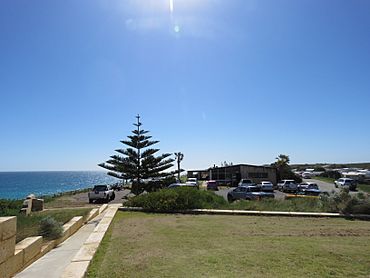Seabird, Western Australia facts for kids
Quick facts for kids SeabirdWestern Australia |
|
|---|---|

Seabird Tavern overlooking the coast in September 2021
|
|
| Established | 1968 |
| Postcode(s) | 6042 |
| Area | [convert: needs a number] |
| Location | |
| LGA(s) | Shire of Gingin |
| State electorate(s) | Moore |
| Federal Division(s) | Pearce |
Seabird is a small town located right on the coast in Western Australia. You can find it north of Perth, in the area called the Shire of Gingin. It sits about halfway between the towns of Two Rocks and Lancelin, with great views of the Indian Ocean.
Seabird is a popular spot for holidays and for people who want to retire by the sea. It's a bit like other nearby towns such as Guilderton and Ledge Point. However, Seabird is also well-known for its challenges with the ocean slowly wearing away its coastline.
Seabird's Story
The area where Seabird now stands started out in the 1950s. It was just a collection of simple shacks built on sand dunes. These shacks were used by people who fished for rock lobsters.
In 1965, a decision was made to officially name this area as a townsite. They first planned to call it "Chalon." This name came from the hometown of a botanist, Jean-Baptiste Leschenault de La Tour. However, the people living there didn't like the name "Chalon."
How Seabird Got Its Name
When the town was officially named in 1968, it was changed to "Seabird." This name came from a schooner (a type of sailing ship) called "Sea Bird." This ship was wrecked in the area back in 1874. The ship's name had already been used for a nearby farming area.
Facing the Ocean's Power
Seabird is built on sand dunes very close to the beach. Because of this, a report in the 1970s suggested that no more buildings should be put up in the town. This warning came true when the ocean started to wash away the land. About 40 metres of land disappeared! A road called Turner Street, which served beachfront homes, actually collapsed into the ocean.
In 2016, local residents worked hard to get help. As a result, a large sea wall was built. This wall cost about $2 million Australian Dollars. It was designed to protect the homes near the beach for another 10 to 20 years. To help even more, 2,400 native plants were added behind the sea wall. These plants help to make the area more stable and prevent further erosion.


